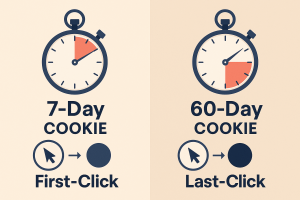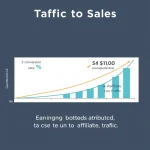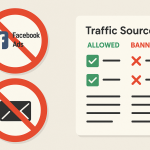How to Vet Affiliate Offers Before Promoting
5 Smart Questions That Ensure Internet Profit Success

Affiliate marketing sounds dreamy: share links, make commissions, maybe drink coffee on a beach one day. But scratch the surface, and you’ll see not all affiliate offers are built the same. If you pick the wrong offer, you waste time, effort, and credibility, plus, you might screw up your chances of Internet Profit Success.
Here’s a deep dive, with extra context, examples, and actionable tips, on how to vet affiliate offers before promoting. Think of this as your affiliate offer vetting checklist. Use it to sniff out good ones, avoid duds, and build something that really converts.
Why You Must Ask These Questions Before Promoting an Affiliate Product
Before we go into the five smart questions, let’s get clear why this matters:
Affiliate offers vary wildly. Great commission but terrible conversion. High cookie period but crappy attribution.
Your time & audience matter. If you promote low‑quality or misleading offers, your reputation might suffer.
Without drilling into the details, you’ll miscalculate your actual earnings, burn your budget (if using paid ads), or simply underperform.
If you want Internet Profit Success, you need clarity up front. These questions build that foundation.
The 5 Smart Questions to Vet an Affiliate Offer First
Here are the five crucial questions, expanded with extra insight, examples, plus action steps. Each one is a pivot point: get it right, boost chances of success; skip or gloss over it, costliest regrets.
1. What Is the Commission Structure and Potential Earnings?
What does “making money” really mean here?
Does the offer pay a flat fee per sale, or a percentage of the product price?
s the commission tiered (higher rates after certain sales thresholds), or recurring (e.g. subscription‑based so you earn over time)?

Why it matters
High percentage commission on a low‑price product may still give you little. If you promote a $10 product at 50%, you make $5 per sale. Promoting a $200 product at 20% means $40. Also, recurring commissions (or upgrades) can greatly increase lifetime earnings.
Action steps
Write down the commission % and the average order value (AOV).
Do simple math: what you’d earn on 100, 500, 1,000 sales.
If there’s tiering or bonuses (e.g. upon reaching $5,000 in sales/month), factor those in.
Example
If the product is $50, commission is 30%, then each sale gives you $15. If you get 100 sales, that’s $1,500. If it’s subscription‑based and you get repeat purchases, that multiplies over time.
2. How Long Is the Cookie Duration and What Attribution Model Do They Use?

Cookies are not just for privacy; they track when someone clicks your link, so you know when to get paid. Attribution models decide who gets credit when someone uses multiple paths to buy.
Key things to check
Cookie length (7 days? 30? 90?): longer tends to be safer, but there’s often trade‑offs.
First‑click vs last‑click attribution: if someone clicks your link, later clicks via another channel before buying, do you still get credit?
Why it matters
Short cookies mean lost earnings if people don’t buy right away. Attribution models that favor last‑click might mean other channels steal credit from you. If you build content, email, ads etc., this matters.
Action steps
Get cookie duration from the affiliate program’s docs.
Ask what attribution type they use.
Compare with at least 2‑3 other offers in the same niche. Longer cookies or favorable attribution = more upside.
Example
An offer with a 60‑day cookie and first‑click attribution is safer for you than one with a 7‑day cookie and last‑click attribution. If someone reads your review today, later clicks your link via newsletter or ad, you want to ensure you're credited.
3. What Is the Conversion Rate & Average Order Value (AOV)?
High commission + long cookie = good deal… if people actually buy and spend enough.
What to ask
What % of people who click become buyers? (Conversion rate)
What amount do people statistically spend on average per order? (AOV)

Any data by traffic source? (Email, social media, paid ads, etc.)
Why it matters
Low conversion kills volume. Even with high commission, low conversion means many clicks for little return. AOV affects how much you can make per conversion. Also, knowing conversion by source helps you decide where to invest effort.
Action steps
Ask affiliate manager for historical conversion rates.
Estimate your earnings per 1,000 clicks by plugging in conversion and AOV.
Consider benchmark data in your niche (e.g. in tech, physical goods, digital products) so you know what “good” looks like.
Example
If conversion rate is 2% and AOV $100, with a $40 commission per sale, then per 1,000 clicks you get 20 sales × $40 = $800. If AOV is smaller or conversion much lower, adjust expectations.
4. Are There Any Restrictions or Special Requirements?
This one catches newbies off‑guard a lot. Terms matter.
Things to verify
Which traffic sources are allowed or disallowed? (e.g. email, paid ads, social, influencer content)
Are there any geographic restrictions? Maybe the offer only pays in certain countries.
Do you need to meet some preconditions? (e.g. minimum sales, proof of traffic, vetting)
Any rules about creative usage: claims, refund policy, required disclaimers, brand guidelines.

Why it matters
If you invest in ads but the offer bans them, that’s wasted money and possibly account risk. If your audience location is outside the allowed ones, you may get zero conversions. Violating terms can lead to getting cut off or unpaid commissions.
Action steps
Read the affiliate program’s terms & conditions carefully.
List allowed vs disallowed promo methods.
If in doubt, ask the affiliate manager: “If I promote via influencer ads / email list in country X, is that okay?”
Example
Offer says no Facebook paid traffic. Your channel is heavily Facebook‑ads based: either you adapt or avoid. Or they only pay commissions on sales from US, but most of your audience is UK, that’s a mismatch.
5. What Support and Promotional Materials Do They Provide?
Even the best affiliate links need good tools to convert. Your success is easier when the program helps you.
What to check
Do they provide banners, creatives, swipe copy, product images that are ready‑to‑use?
Is there a media kit? Deep linking options (so you link to specific product pages, not just home pages)?

Does the offer provide performance dashboards where you can see in real time clicks, conversions, earnings etc.?
Is affiliate support responsive? Maybe training, webinars, or tips on what works.
Why it matters
Good creatives save you time and help maintain brand consistency. Dashboards track what’s working vs what’s not. Responsive affiliate manager = faster resolution of issues, better insights. All this improves conversion and helps you scale.
Action steps
Request access to their media assets.
Try reaching their support and see speed & helpfulness.
Check what tracking & reporting tools they offer.
Example
One offer gives you an affiliate dashboard that shows clicks by location, conversion rates by traffic source, AOV, etc. Another gives you only a monthly vague statement. The first one helps you optimize; the second one leaves you guessing.
Additional Considerations for Affiliate Offer Vetting Checklist
Beyond those five core questions, here are more angles you should think through to increase chances of Internet Profit Success:
Niche Fit & Relevance
No matter how generous an affiliate offer looks, if it doesn’t align well with your audience or niche, it’s unlikely to convert.
If you write about vegan cooking, promoting high‑calorie meat products is mismatch.
Consider overlap in values, audience demographics, pain points.
Audience trust is fragile; promoting irrelevant or misleading offers may damage it.
Refund Rates, Returns & Post‑Sale Experience
Even after someone buys, if they request refund or return often, your net earnings suffer (especially if the merchant claw‑backs commissions on returns).
Ask affiliate manager: what is typical refund rate?
What customer support / shipping etc does the merchant provide?
Lower refund rates = more stable earnings.
Payment Terms & Minimum Payout
You want to ensure you’ll actually receive what you earn, on schedule.
How often do they pay (monthly, bi‑monthly)?
Minimum payout threshold (e.g. you must reach $100 before they pay)
Are there fees/deductions?
Long waits or high thresholds can mess with cash flow, especially when starting out.
Tracking, Fraud & Transparency
Is tracking reliable?
Do they have fraud prevention? Sometimes affiliates see their clicks / conversions reversed due to fraud or invalid traffic.
Are reporting tools granular & transparent?
Longevity & Stability of Merchant / Product
Is the merchant reliable & reputable?
How established is the product? Is it likely to remain in the market?
Are there reviews / feedback from other affiliates?
If the merchant disappears or changes terms drastically, that can wipe out future profits..
Example Walk‑Through: Vetting Two Offers Side by Side
Let’s pretend you have two affiliate offers (Offer A & Offer B) in the tech gadget niche. Here’s how you might vet them:
Offer A
25% commission, flat; no recurring.
Cookie 14 days; last‑click attribution.
Conversion rate ~1.5%; AOV $120.
No paid ads allowed; social & email okay.
Media kit limited; no swipe copy; basic dashboard.
Merchant is small start‑up; mixed reviews; 8% refund rate.
Pays monthly; $200 minimum.
Offer B
40% commission + 5% bonus for 500+ sales/month; recurring subscription add‑ons.
Cookie 60 days; first‑click attribution.
Conversion rate ~2.5%; AOV $90.
All traffic sources allowed, but paid search needs approval.
Good media kit; swipe copy; deep linking; advanced dashboard.
Merchant is well‑known brand; low refund rate; good reviews.
Payout monthly; $50 minimum.
You plug these into the checklist. You see Offer B scores higher on many rows (commission structure, cookie & attribution, assets, merchant stability etc.), even though Offer A has slightly higher AOV. Offer B offers better odds for Internet Profit Success because it has more favorable terms overall.
How to Negotiate & Ask Smart Questions (So You Don’t Get Surprised)
When talking with affiliate managers or programs, phrasing matters. Here are ways to get clarity and maybe better terms:
“Can you send me your standard commission structure + any bonuses/tiers you offer?”
“What is your cookie duration and attribution model? Could I see actual reference data?”
“What are your historical conversion rates & AOVs for affiliates in my niche?”
“Could you confirm whether [traffic source X] is allowed?”
“What creatives / resources do you have? Deep‑linking? Are there banners / swipe emails / video assets?”
“What is your refund/return policy / how does it affect affiliate commissions?”
“When & how do you pay affiliates, and what is the minimum payout / required documentation?”
Often, affiliate managers are open to answering. If they brush off the questions, that’s a red flag.
Realistic Estimates & Planning for Internet Profit Success
Even with great offers, profitability depends on how well you plan. Here’s how to set realistic expectations and strategy:
Start small: test a few offers using low‑cost traffic or organic channels to see what converts.
Track everything: not just clicks, but conversions, where traffic comes from, what creatives work. Use your dashboard + external analytics.
Optimize over time: swap out banners, refine messaging, try different traffic methods.
Build content around offers: reviews, tutorials, comparisons attract buyers.
Diversify: don’t rely on a single offer or merchant. Spread risk.
Common Pitfalls & How to Avoid Them
To hit Internet Profit Success, watch out for these traps:
Being seduced by high commission percentages but ignoring conversion or audience mismatch.
Overlooking terms that disallow your best traffic sources. Then spend lots of time / money, only to get disallowed or zero earnings.
Not accounting for refunds or returns which reduce net commissions.
Using poor creatives or promoting via bad messaging, even good offers suffer if your promotion is weak.
Ignoring cooling periods: some affiliate programs change terms, reduce rates, or shut down. Stay updated and be ready to pivot.
SEO & Content Tips: Using the Keyword “How to Vet Affiliate Offers Before Promoting” etc.
Since you’re writing this kind of content, sprinkle the main keyword and related ones in strategic places. Like:
In the title (we already have that).
In at least one heading (ex: “How to Vet Affiliate Offers Before Promoting: Conversion Rate & AOV”)
Early in the introduction.
Naturally in some body paragraphs, especially where you describe the issue or process.
In conclusion / summary.
Don’t force it; maintain readability. Google and readers both prefer content that flows.
Summary: Your Affiliate Offer Vetting Checklist for Internet Profit Success
To wrap up:
Always check the commission structure & earnings potential.
Know the cookie duration & attribution model.
Understand conversion rate & average order value.
Clarify any restrictions or special requirements.
See what support/resources/promotional materials are offered.
Add in niche fit, refund rates, payment terms, tracking & merchant stability. Use your checklist every time. Compare offers side by side. Negotiate where possible. Test, track, optimize.
Follow this process, and you’ll be far more likely to pick affiliate offers that actually deliver results, not just promise them. That’s how you build sustainable Internet Profit Success.
